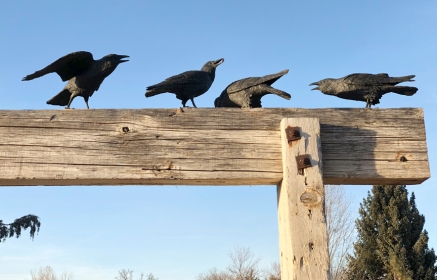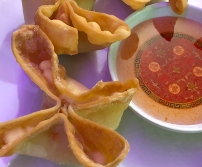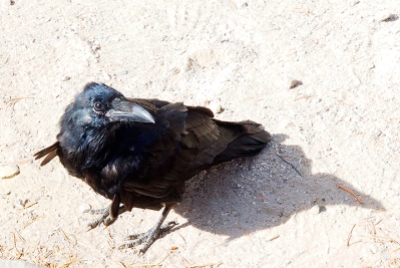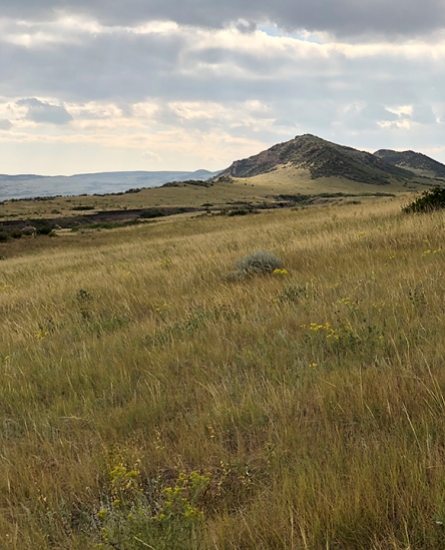Last week a friend and I drove out to Pawnee Buttes, in the Pawnee National Grassland. This is on the prairie in northeast Colorado, not far south of Wyoming and Nebraska. It was a warm but lovely day. The grassland is beautiful: lots of miles on dirt roads; beautiful undulating hills; and the isolated buttes themselves. The only downside is the sheer number of oil and gas facilities out here, along with the accompanying truck traffic. In a time when it’s imperative that we phase out fossil fuels, I was discouraged to see the amount of fracking and other fossil-fuel extraction on this, one of our national treasures.
Great Plains
Fog, frozen, fleeting ~

Frozen fog coating trees along I-25

A view to the northeast
We’ve had freezing fog the past couple of nights. Here’s what it looked like on the trees and plains bordering the interstate north of Fort Collins, not too far south of the Wyoming border. The sky wasn’t really sunny, and all of the colors were muted. Interstate exits are infrequent on I-25 between north Fort Collins and Cheyenne, and the one that would have worked looked to be blocked by an accident, so I finally pulled off onto the shoulder and shot through the side windows and windshield. Don’t like to do that for photographs, but this was too beautiful to pass up.
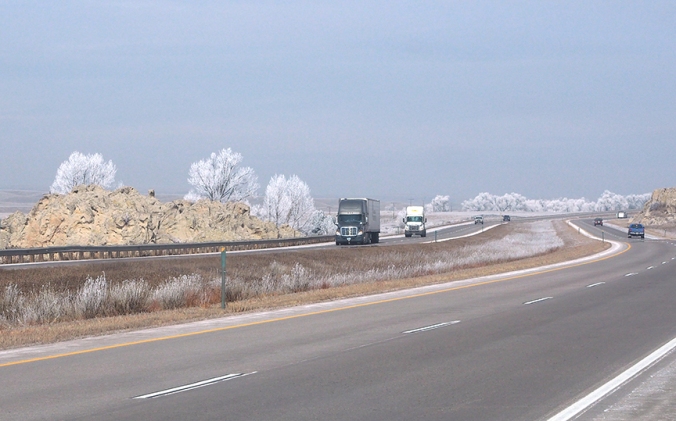
Heading north on I-25
Clouds to the west ~
These were taken yesterday evening in Longmont. The iPhone is not good at handling sunset light. The photo with the tree is pretty true in terms of color, and I was able to color-correct the image at bottom right reasonably well. For the other two I gave up and decided to just enjoy that inky blue.
Animal favorites ~

Taking Watch, by Parker Macdonald, Benson Sculpture Garden
I went to Benson Sculpture Garden to walk.
Really, I did. It didn’t even occur to me to take my Olympus along. The only reason I had my cell phone with me was that I was expecting a call from the vet. But I couldn’t seem to get very far down the path without pulling out my phone and taking photographs.
Benson Sculpture Garden is a very popular place for people to exercise, and in particular to walk their dogs. How they manage this, I don’t understand. I tried it once, not too long after moving to Loveland, and discovered that there is no “walking” my little dogs, Ginger and Punkin, at Benson; there is only hanging onto them, barely. The scent of other dogs is so strong that it acts upon them as an irresistible elixir, causing them to pull and tug and drag and stand rooted on spot after spot. My wrists and hands ached so badly by the time we finished our circuit that I’ve never taken them back. On Friday I watched in amazement as other people walked their dogs quite calmly along the curving paths and past the dozens of sculptures. Are my dogs really the worst? It would seem so, which makes me the worst dog owner.
Anyway, dogs aside, above and below are some of my animal favorites from the sculptures. It was the wrong time of day for the best view of the octopus, so I have a shot with a house prominently in the background. And I could have used a shallow depth of field for the cougar, but: iPhone.
The octopus lends itself to delicious closeups, some of which I’m including here to justify making this post. Hope you enjoy them.
Warped blinds ~
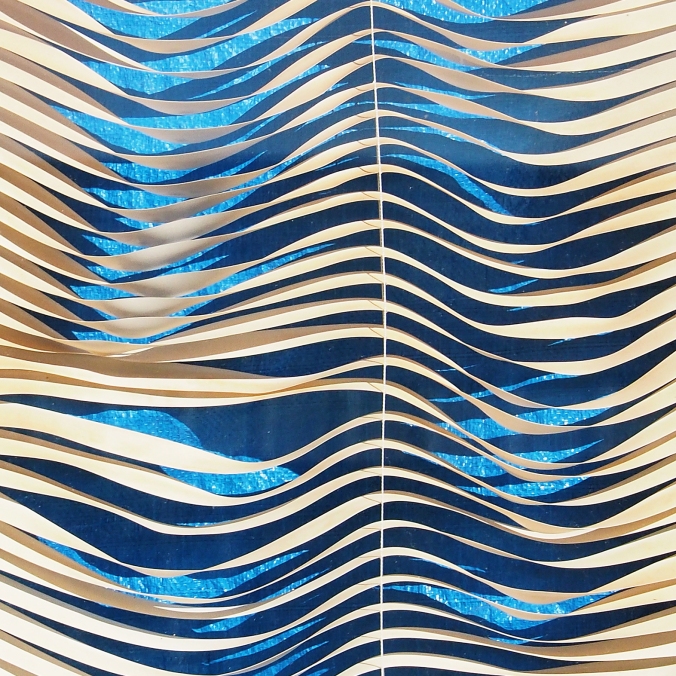
Warped blinds
Taken at an abandoned gas station in Powder River, Wyoming.
Driving from Casper to Thermopolis ~
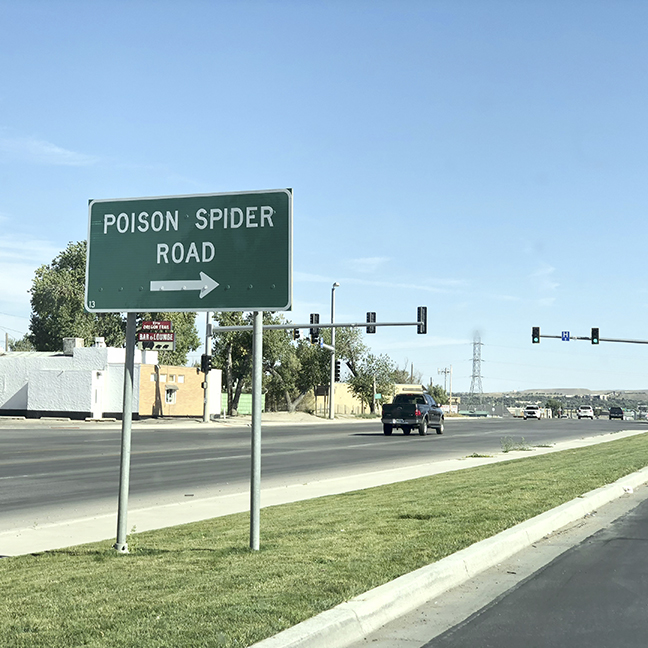
Poison Spider Road, Casper
Farther west of Casper, in the vicinity of Powder River, Wyoming, I passed a couple of antelope virtually on the road, so I pulled off at the same spot where a man driving a pickup-trailer also had pulled off. He wasn’t taking photos; he was adjusting something more securely on the trailer. As I pulled off, I noticed the Tumble Inn sign and pointed my camera there first, since the antelope had moved off some distance. The man walked over after a few moments and said, “That’s an iconic sign. Somebody should take it and preserve it.” I agreed that it would be a great shame if it were to be destroyed. He shared with me the information that the now-defunct (and derelict) Tumble Inn had at one time featured a topless dancer, and that men driving to and from this place, which is sited outside the regulatory reach of Casper (to the east) and Shoshoni (to the west), had occasionally met their demise thanks to drunk driving.

The defunct Tumble Inn, Powder River, Wyoming
The man reacted with dismay when he heard that I was headed to Yellowstone, which led to a conversation about the sheer numbers of park visitors and the crowded scenic drives in Colorado. “Everybody loves Colorado, but they’re going to love until they ruin it,” he said, and we speculated as to whether this had already happened. The man, who introduced himself as Gary and who was probably in his 60s, said that he was Arapaho, and that the traditional Arapaho territory was in the Loveland-Estes Park-Fort Collins area, where I now live. He himself had lived in Wyoming almost his whole life and owned a ranch near Riverton, on the Wind River Indian Reservation. His hair was tied back in a short, skinny ponytail that seemed unexpected given the rest of his haircut. He stuck out his hand when he introduced himself at the end of the conversation, saying “Maybe we’ll meet again down the road.” We didn’t, of course, but I would have liked talking to him more about his Wyoming.

Abandoned gas station, Powder River, Wyoming
At Shoshone U.S. Highway 20 turns north and eventually runs parallel to Wind River for several curving, beautiful miles. The traffic through Wind River Canyon is fast. I caught sight of a few signs marking geological time in the rocks exposed by the river. The first one I spotted said “Gros Ventre Formation — Cambrian.” The last one, “Chugwater Formation — Triassic,” indicated ochre-colored hills. In between I saw signs for Devonian- and Permian-age formations; there may have been others that I missed while zipping down the canyon with cars on my bumper, or while trying to find picture-taking sites. All told, the progression down the canyon covered more than 250 million years of geological time. I wished I had a miniature John McPhee, or a miniature geologist, on my shoulder to narrate details about the passage; it would be worth another trip to study the changes. Wikipedia says that the canyon was formed by tectonic shifts, not by river cutting.
The geology of Wyoming, or at least some of it, is the subject of McPhee’s excellent “Rising from the Plains,” one volume in his five-volume “Annals of the Former World.” McPhee, in consultation with geologist David Love of Laramie, reconstructs the geological events that led to Wyoming’s strange plethora of cross-cutting mountain ranges, many of which defy the dominant north-south trend of the Rockies. Despite having read this book three times, I can’t remember the particulars, but they can be summed up as “It’s complicated.” McPhee intercuts his story with tales of pioneer days, including fascinating excerpts from a journal kept by Love’s mother, who came to central Wyoming in 1905 as a frontier schoolteacher. I recommend both McPhee’s book and Annie Proulx’s “At Close Range: Wyoming Stories,” which jointly paint a picture of hardship and human extremes that parallel the extremes of the climate and the countryside here.

Igneous intrusions, Wind River Canyon
Not scenery ~
Some non-scenic sights from my recent road trip to Wyoming/Montana.
Solitude on the high plains ~
This afternoon I drove up to Soapstone Prairie Natural Area, located about 15 miles north of Fort Collins and about 10 miles south of the Wyoming border. The last several miles are on a very well graded dirt-and-pea-gravel road. I went to the north parking lot, where there was only one other car, and walked a short trail to a site that overlooks a former archaeological dig, now restored to prairie. This is some of what I saw. I’m still working on an identification for a couple of the plants. I’m also a bit puzzled by the rocks atop the fenceposts—are they decorative, or do they have some sort of significance I can’t read?
The sense of remoteness and the solitude were gratifying, very different from the isolation of being at home. It was a beautiful, unusually cool day for August and it was windy; my ears actually got cold. I was fine in a T-shirt but began thinking longingly of earmuffs; what a strange sight that combination would make! A hat or scarf would have done the trick. I want to return to this area soon with my Olympus and my binoculars.
Note: I have since learned that the purpose of the rocks is to divert water, thus preventing deterioration of the tops of the posts. Thanks to Michael Bliss for telling me this.
The spider and the hawk ~
With the exception of various insects and one very loud flock of Canada geese passing overhead, that’s all I saw today at the Frank State Wildlife Area, a bit southeast of Fort Collins on the Cache la Poudre River trail. And I don’t have a photo of either. The spider was a spindly thing the color of a liver spot; the hawk was far away. (I actually saw the spider a second time, on the way back. It had moved just slightly on the trail. Perhaps it wasn’t feeling well.)
Concrete is not what I think of as a trail, but this little section drew a lot of cyclists and walkers today, when the temperature was in the upper seventies. My dogs and I walked for about an hour. We didn’t cover much territory—less than 2 miles—but we were all thirsty and hot long before we got back to the car.
Frank S.W.A. is made up of recently reclaimed gravel pits, and parts of the area have been closed as recently as late 2015 for mining. I could hear traffic noise from a nearby two-lane highway the whole way—except for moments when the wind picked up. I’m still looking for a place to go out here on the plains near Loveland that doesn’t feature lots of traffic noise, or a view of houses. It was a nice walk, though, and will be much nicer when the trees leaf out. These are iPhone photos, rendered a bit shakier than usual due to the wind.
Am I too blue for you? ~

Another iPhone photo, color intensified. Taken at Bowl Plaza in Lucas, Kansas. The title is a Lucinda Williams song from her self-titled album. (We don’t need to say “eponymous,” do we? Good.)












